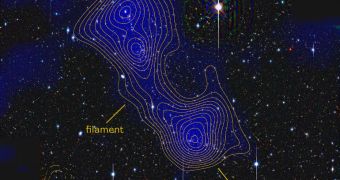Experts at the University Observatory Munich, in Germany, led by astronomer Jörg Dietrich, announce the discovery of a massive dark matter bridge connecting Abell 222 and Abel 223. The latter are two massive clusters, each containing thousands of galaxies.
Believed to be made out of Weakly-Interacting Massive Particles (WIMP) – which are their own antiparticles – dark matter does not readily interact with regular (baryonic) matter, except through the force of gravity.
Therefore, astrophysicists cannot observe it directly, but rather have to analyze the gravitational influence it exerts on stars, solar systems, galaxies, clusters and superclusters, Space reports.
Located around 2.7 billion light-years away, the two clusters are believed to be joined together by dark matter, which appears shaped as a bridge from our current position. Experts believe that the entire Universe is permeated by these strings of dark matter, which create an unbelievably large web.
Along these strings, galaxies and cluster travel towards intersection points, where they gather to form superclusters and galactic walls, as well as other large-scale cosmic structures. Overall, dark matter accounts for more than 23 percent of the Universe's mass-energy budget.
“This is the first time [a dark matter filament] has been convincingly detected from its gravitational lensing effect," said astronomer Jörg Dietrich of the University Observatory Munich, in Germany. "It's a resounding confirmation of the standard theory of structure formation of the universe. And it's a confirmation people didn't think was possible at this point."
The particularities present in the geometries of these two clusters are what allowed researchers to conduct this study. The team used a phenomenon called gravitational lensing, which allowed them to use galaxies as a giant lens in space.
“The standard wisdom is that the gravitational lensing of filaments is too weak to be detected with current telescopes. Only when we realized this system has such a peculiar geometry did we realize we have a chance,” Dietrich tells Space.
The team now plans to extend its efforts and will focus on detecting other dark matter filaments. Their research is stifled by the fact that instances of clusters positioned in such a way that astronomers can use gravitational lensing to study them are very rare.

 14 DAY TRIAL //
14 DAY TRIAL //